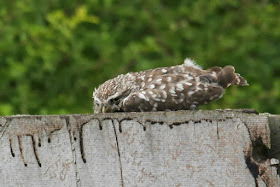The Little Owl used to be a very easy bird to see at any time of the year, but it has declined markedly since 1970. It is very site faithful, as they are mainly sedentary birds, but they can be easier to spot in winter when the leaves surrounding their nesting holes are no longer concealing them.
Little Owls in July
What do you think?
Little Owls are probably the most diurnal of our owls, which means that they are much easier to see in the daytime. On sunny winter afternoons they have a habit of soaking in the late winter sunshine before it gets dark, but they can also be seen sunbathing in the mornings too. On dull days they can be much harder to find.
Taken outside Warter by my nephew (15 at the time)
Before being eaten by Tawny Owls in Thixendale
Little Owls appear mainly dark brown, but a good view allows you to see that they are liberally covered with pale streaks and spots. They are a little larger than Blackbirds, but are certainly much wider! Their pale eyebrows often give them a cross expression, which can look extremely comical, and may be one reason why they are extremely popular with class participants when we do manage to observe an individual.
A Pair from 2018 Calendar Cover (c0 2015 Maggie Bruce
Chicks in West Yorkshire (c) 2015 Mark Waller
Well-grown chicks in South Yorkshire (c) 2015 Dave Simmonite
Little Owls have been located in the British fossil record, but they died out in antiquity. They were reintroduced from continental stock in the 18th and 19th-centuries, and quickly spread throughout much of England. Many introductions, planned or accidental, have caused problems, such as Grey Squirrel, Ruddy Duck, Canada Goose, Black Swan, Ring-necked Parakeets but the Little Owl seems to have found a perfect niche, which doesn't appear to have had any negative consequences on other species, or on the environment.
East Yorkshire (c) 2015 Chris Cox
Dropping like a Brick
Changes in farming practices since 1970 seem to be the main reason behind the decline in this species, and today in East Yorkshire they seem to be confined to farmland near livestock. They feed on moths or large beetles attracted to the dung of sheep, cows or pigs. Of course this diet is supplemented by worms, and small rodents.
In East Yorkshire (c) 2015 Tony Robinson
If you see a Little Owl flying they appear to have all the aerodynamic qualities of a brick! Unfortunately, I've never been able to catch a really good photograph of this species in mid-air, but I will keep on the look-out. Participants on the course will be told the best places to look out for this charismatic species in their localities, and how best to avoid any disturbance to them. There is a famous pair near Beverley, which are perhaps over-visited. Please do not park right next to their tree, but wind you're car window down well before arriving, and park up well away, and on the opposite side of the road, where you should be able to observe them without disturbance.
Playing Dead? (c) 2014 Maggie Bruce
Can they see me? (c) 2014 Maggie Bruce
Maybe? (c) 2014 Maggie Bruce
Nah (c) 2014 Maggie Bruce
Will any of those on the New Year course be as lucky as Maggie who managed to photograph her local owl indulging in extremely bizarre behaviour. She posted her pictures on a forum asking what people thought was happening, answers ranged from suggestions that it was anting, sunbathing, playing dead, or even dying. However, one expert believes that the bird was simply having a snooze in a warm and relatively safe location. Happy Little Owl Hunting!















No comments:
Post a Comment